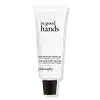What's inside
What's inside
 Key Ingredients
Key Ingredients

 Benefits
Benefits

 Concerns
Concerns

 Ingredients Side-by-side
Ingredients Side-by-side

Water
Skin ConditioningGlycerin
HumectantGlyceryl Stearate
EmollientTheobroma Cacao Seed Butter
EmollientButyrospermum Parkii Butter
Skin ConditioningCetearyl Olivate
Aloe Barbadensis Leaf Juice
Skin ConditioningCetearyl Alcohol
EmollientSorbitan Olivate
EmulsifyingColloidal Oatmeal
AbsorbentStearic Acid
CleansingCaprylic/Capric Triglyceride
MaskingHoney
HumectantXanthan Gum
EmulsifyingTocopherol
AntioxidantHelianthus Annuus Seed Oil
EmollientSodium Hyaluronate
HumectantChamomilla Recutita Oil
MaskingCalendula Officinalis Extract
Skin ConditioningWater, Glycerin, Glyceryl Stearate, Theobroma Cacao Seed Butter, Butyrospermum Parkii Butter, Cetearyl Olivate, Aloe Barbadensis Leaf Juice, Cetearyl Alcohol, Sorbitan Olivate, Colloidal Oatmeal, Stearic Acid, Caprylic/Capric Triglyceride, Honey, Xanthan Gum, Tocopherol, Helianthus Annuus Seed Oil, Sodium Hyaluronate, Chamomilla Recutita Oil, Calendula Officinalis Extract
Water
Skin ConditioningGlycerin
HumectantIsopropyl Myristate
EmollientCetyl Alcohol
EmollientGlyceryl Stearate
EmollientNiacinamide
SmoothingCetyl Esters
EmollientDimethicone
EmollientStearic Acid
CleansingPalmitic Acid
EmollientPropanediol
SolventSaccharide Isomerate
HumectantNeopentyl Glycol Dicaprylate/Dicaprate
EmollientTridecyl Stearate
EmollientAscorbyl Glucoside
AntioxidantC12-15 Alkyl Ethylhexanoate
EmollientCaprylyl Glycol
EmollientPolyacrylate Crosspolymer-6
Emulsion StabilisingButyrospermum Parkii Butter
Skin ConditioningChlorphenesin
AntimicrobialTridecyl Trimellitate
EmollientMacadamia Ternifolia Seed Oil
EmollientOlea Europaea Fruit Oil
MaskingXanthan Gum
EmulsifyingSodium Hydroxide
BufferingSodium Citrate
BufferingAdenosine
Skin ConditioningTrisodium Ethylenediamine Disuccinate
Citric Acid
BufferingMethylpropanediol
SolventGlycyrrhiza Glabra Root Extract
BleachingHyaluronic Acid
HumectantSilanetriol
Water, Glycerin, Isopropyl Myristate, Cetyl Alcohol, Glyceryl Stearate, Niacinamide, Cetyl Esters, Dimethicone, Stearic Acid, Palmitic Acid, Propanediol, Saccharide Isomerate, Neopentyl Glycol Dicaprylate/Dicaprate, Tridecyl Stearate, Ascorbyl Glucoside, C12-15 Alkyl Ethylhexanoate, Caprylyl Glycol, Polyacrylate Crosspolymer-6, Butyrospermum Parkii Butter, Chlorphenesin, Tridecyl Trimellitate, Macadamia Ternifolia Seed Oil, Olea Europaea Fruit Oil, Xanthan Gum, Sodium Hydroxide, Sodium Citrate, Adenosine, Trisodium Ethylenediamine Disuccinate, Citric Acid, Methylpropanediol, Glycyrrhiza Glabra Root Extract, Hyaluronic Acid, Silanetriol
Ingredients Explained
These ingredients are found in both products.
Ingredients higher up in an ingredient list are typically present in a larger amount.
This ingredient is also known as shea butter. It is an effective skin hydrator and emollient.
Emollients help soothe and soften your skin. It does this by creating a protective film on your skin. This barrier helps trap moisture and keeps your skin hydrated. Emollients may be effective at treating dry or itchy skin.
Shea butter is rich in antioxidants. Antioxidants help fight free-radicals, or molecules that may harm the body. It is also full of fatty acids including stearic acid and linoleic acid. These acids help replenish the skin and keep skin moisturized.
While Shea Butter has an SPF rating of about 3-4, it is not a sunscreen replacement.
Shea butter may not be fungal acne safe. We recommend speaking with a professional if you have any concerns.
Learn more about Butyrospermum Parkii ButterGlycerin is already naturally found in your skin. It helps moisturize and protect your skin.
A study from 2016 found glycerin to be more effective as a humectant than AHAs and hyaluronic acid.
As a humectant, it helps the skin stay hydrated by pulling moisture to your skin. The low molecular weight of glycerin allows it to pull moisture into the deeper layers of your skin.
Hydrated skin improves your skin barrier; Your skin barrier helps protect against irritants and bacteria.
Glycerin has also been found to have antimicrobial and antiviral properties. Due to these properties, glycerin is often used in wound and burn treatments.
In cosmetics, glycerin is usually derived from plants such as soybean or palm. However, it can also be sourced from animals, such as tallow or animal fat.
This ingredient is organic, colorless, odorless, and non-toxic.
Glycerin is the name for this ingredient in American English. British English uses Glycerol/Glycerine.
Learn more about GlycerinGlyceryl Stearate is a mix of glycerin and stearic acid.
It is used to stabilize the mixing of water and oil ingredients. By preventing these ingredients from separating, it can help elongate shelf life. It can also help thicken the product's texture.
As an emollient, it helps soften skin and supports barrier-replenishing ingredients.
In cosmetics, Glyceryl Stearate is often made from vegetable oils or synthetically produced.
This ingredient may not be fungal-acne safe
Fun fact: The human body also creates Glyceryl Stearate naturally.
Learn more about Glyceryl StearateStearic Acid is a fatty acid. It is an emollient, emulsifier, and texture enhancer.
As an emollient, stearic acid helps soften skin. It aids the skin's protective barrier by preventing water loss. It also provides a gentle cleansing effect without stripping away natural oils.
Stearic acid may also be used to enhance the texture of products. It can add volume and stabilize ingredients such as water and oil. This can help water and oil ingredients from separating.
Sources of stearic acid include animal or vegetable fats/oils such as coconut or shea. It can be naturally found in butter, cocoa butter, shea butter, vegetable fats, and animal tallow.
This ingredient may not be Malassezia folliculitis, or fungal-acne safe.
Learn more about Stearic AcidWater. It's the most common cosmetic ingredient of all. You'll usually see it at the top of ingredient lists, meaning that it makes up the largest part of the product.
So why is it so popular? Water most often acts as a solvent - this means that it helps dissolve other ingredients into the formulation.
You'll also recognize water as that liquid we all need to stay alive. If you see this, drink a glass of water. Stay hydrated!
Learn more about WaterXanthan gum is used as a stabilizer and thickener within cosmetic products. It helps give products a sticky, thick feeling - preventing them from being too runny.
On the technical side of things, xanthan gum is a polysaccharide - a combination consisting of multiple sugar molecules bonded together.
Xanthan gum is a pretty common and great ingredient. It is a natural, non-toxic, non-irritating ingredient that is also commonly used in food products.
Learn more about Xanthan Gum